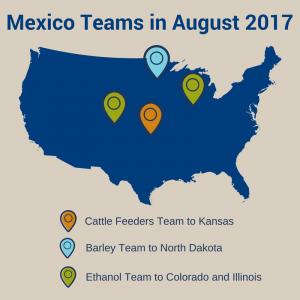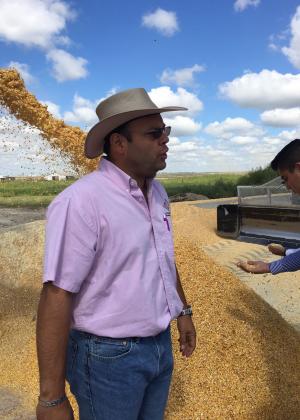At first glance, cattle feeders from Mexico may not appear to have much in common with Corona beer or the Mexican media. Yet each has a common reason for traveling to the United States in late August: learning more about the potential for collaboration and increased business between the United States and Mexico.
Mexico was the largest export market for U.S. corn in the last full marketing year, purchasing 13.3 million metric tons (524.4 million bushels), in addition to 606,127 tons (23.86 million bushels) of sorghum, 115,000 tons (5.3 million bushels) of barley and 1.9 million tons of distillers dried grains with solubles (DDGS). In all, these exports were valued at $2.97 billion.
The two trading partners share one of the most efficient and integrated supply chains in the world, thanks to two decades of economic development facilitated by the North American Free Trade Agreement (NAFTA), common geography and market development work by organizations like the U.S. Grains Council (USGC).
The country also now represents a potential ethanol market of 720 million gallons, the equivalent of 6.41 million metric tons (252.6 million bushels) of corn, thanks to a recent regulatory change.
As part of the Council’s work to help Mexican industries using U.S. grains succeed while increasing their overall demand, the Council regularly brings teams to the United States to learn more about these products from the field to end-user, whether that is a cattle producer, a brewer or a fuel blender.
Brewing Mexican Beer With U.S. Barley
The terms of NAFTA provided immediate duty-free access for U.S. barley and malt into Mexico, making them attractive options for beer makers who depend on imports. As a result, Mexico purchased more than 680,000 tons (31.2 million bushels) of U.S. barley valued at $220 million over the last 10 marketing years, driven by the Mexican brewing industry. A good portion of the beer brewed with those imports later travels back across the border as imported beer, including through recognizable brands like Corona.
Constellation Brands produces 27 million barrels of beer annually, sourcing much of their barley and malt from the United States. The team traveling to North Dakota recently included both procurement managers and analysts from the company.
Their activities focused on sourcing, including a seminar at North Dakota State University’s Center for Risk and Trading on buying strategies and an education program arranged by the North Dakota Barley Council on malt barley contract price determination and related inventory management concerns.
Perhaps just as importantly, Constellation team members met face-to-face with North Dakota barley farmers, further reinforcing the dedication of the United States to continued business.
“The real purpose for this team was to get to know the farmers and the field so Constellation could grasp what it means to work directly with them,” said Javier Chavez, marketing specialist with USGC’s Mexico office. “The team visited a field for the first time in their lives, bringing them the experience of what harvest is all about and all it takes to get there, from deciding what to plant to taking care of the crop to fulfilling a plentiful harvest with good-quality grain.”
Continuing Cattle Feeder Collaboration
This exchange of information between industries occurs on both sides of the border. A recent team of cattle producers from northeast Mexico was a reciprocal trip to see Kansas cattle feeders who visited Mexico in March to establish connections with the Association of Cattle Feeders in Northeast Mexico in Monterrey. The Mexican team included the entire association board as well as the association’s director and two grain purchasers.
The group visited three feedlots, three ethanol plants, a farm, a feedstock producer and a processing facility, arranged by Kansas Corn. During these meetings, team members asked questions and compared feeding practices, cattle organization, electronic tagging and even the latest in using Bluetooth technology to detect breathing issues.
“This type of collaborative work is important because although these groups are technically competitors, they are also partners,” said Heidi Bringenberg, assistant director in USGC’s Mexico office. “The cattle industry is a great example of a NAFTA success story. Whether that is U.S.-purchased genetics going into Mexico or feeding, processing and packaging that takes place across borders to serve final consumers, beef is an integrated joint venture between the United States and Mexico.”
The trading company on the team imports 20,000 tons of grain from the United States each month to feed 280,000 head of cattle, with corn representing the bulk of these imports. One goal of this visit was to increase interest in U.S. DDGS by discussing color, protein levels and consistency with the association’s nutritionist.
The group also visited a corn farmer in southwest Kansas who is conducting water conservation research on his farm with corn and soybeans. His climate and soil compare to that in northern Mexico, which is facing similar water constraints.
“Visits like this are always great for our customers to see conservation in action – innovation, future thinking and resource use by farmers who care about sustainably supplying the world,” Bringenberg said.
Educating Mexican Media About Ethanol
The third team traveling in the United States also is emphasizing on innovation and sustainability by focusing on ethanol.
The Council arranged for a group of Mexico-based energy and economy media members to travel to Denver and Chicago to learn about U.S. ethanol production, integration in the agricultural economy as well as regulation and standards. The team visited the National Renewable Energy Laboratory in Denver, Colorado, as well as with the University of Illinois, the American Lung Association and the U.S. Environmental Protection Agency (EPA) in Chicago. They also toured an ethanol plant in Illinois.
A recent regulatory change in Mexico has huge potential payoffs for U.S. ethanol exports. On June 15, the Mexican Energy Regulatory Commission, known as the CRE, announced an increase to the maximum amount of ethanol that can be blended in Mexican gas supplies from 5.8 percent to 10 percent, except in the cities of Monterrey, Guadalajara and Mexico City.
The Council has worked with local partners to promote ethanol as the fuel component of choice for a more environmentally-friendly Mexican gasoline that helps reduce greenhouse gas pollution. The Council is also working with Mexican leaders as they seek to build their own biofuels industry, which would help support the rural Mexican economy and offer cleaner fuels for the Mexican people.
Establishing imports of U.S. ethanol into Mexico starts with offering information to industry partners and government regulators, including through the media also consumed by the general public. The stories produced by the ethanol media team members will play a critical role in building and capturing this new demand for ethanol in Mexico.
Together, these teams represent market potential across industries – for both U.S. feed grains and co-products as well as expanding cattle feeding, brewing and fuel blending businesses in Mexico. The terms of NAFTA provided the market access for the Council to shepherd these collaborations, but the economies between the two nations are now intermingled, successful and a very good deal for business on both sides of the border.
Learn more about the Council’s work in Mexico here.



